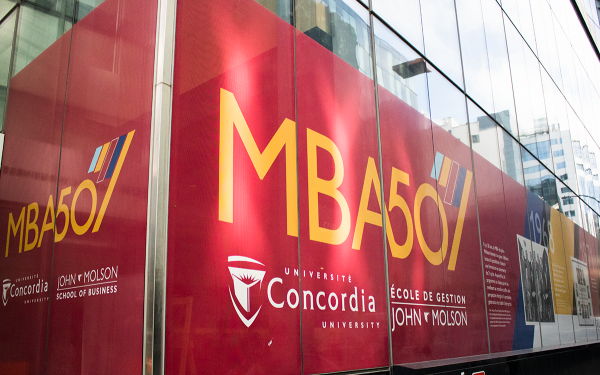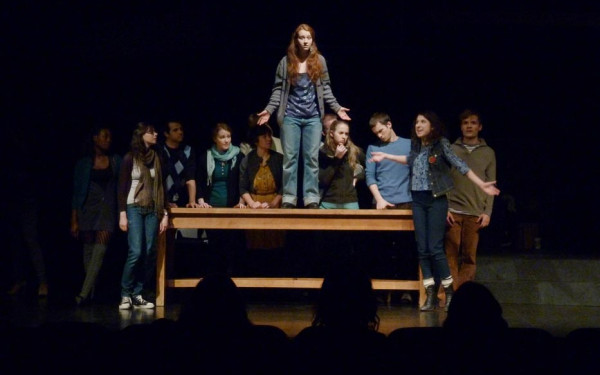Buying, Selling and a Whole Lot of Shouting at JMSB
Finance and Investment Students’ Association Hosts Lively Stock Exchange Simulation
Complete with men and women bustling around in suits, traders shouting out bids to one another from across the room and two giant screens projecting the market value of consumer goods and commodities, the John Molson School of Business building’s lobby had all the makings of a real-life stock exchange on Saturday.
All of the action was part of an annual stock exchange simulation organized by the Finance and Investment Students’ Association. A total of 204 students from Concordia and other universities in Quebec and Ontario participated in the so-called John Molson Stock Exchange, which simulated an open-outcry market for a fourth straight year.
“It’s the first year in four that we’ve sold-out,” said FISA President Steffi Hudier.
According to Hudier, the JMSX simulation is the only open-outcry simulation in Quebec, with other stock exchange simulations in the province using virtual trading instead.
In electronic trading systems, an electronic platform brings buyers and sellers together, but in open-outcry markets, buyers and sellers have to communicate through hand signals and shout out offers and bids at one another in order to arrive at a deal.
Open-outcry markets are increasingly a dying breed, with the likes of the NASDAQ, the London Stock Exchange and the Toronto Stock Exchange all adopting virtual trading environments over the past four decades.
Still, the traditional trading floor survives in hybrid markets like the New York Stock Exchange, and it serves as the iconic image that comes to mind when many people think of a stock market.
“It’s good to get a feel of how it used to be,” said Javier Hernandez-Cotton, a JMSB finance student and participant in the simulation. “It gives you a little bit of perspective about how they worked back then compared to how they work now.”
Another participant and JMSB finance student, Gabrielle Auclair, said there was “an atmosphere of urgency” on the simulated trading floor.
“Everybody really wants to get their [desired] price,” she said.
For Jennifer Paragios, the event’s lead organizer, the open-outcry model offers an unparalleled experience to participants.
“If you’re expected to be screaming out loud, even the shiest person in the [room] will be, at the end, so aggressive,” Paragios said, adding that participants are truly drawn into the simulation. “I sell the experience [to potential participants]. I don’t sell the knowledge added, because it’s a simulation and it’s not 100 per cent realistic.”
Monetary awards totaled $5,000, divided among three team prizes and three individual prizes whose winners were determined by the total amount of simulated profit made by the participants.
But Peter Economou, a JMSB student and participant, said the simulation is principally about having fun.
“[The simulation] gets people interested, it might be that spark that’ll get someone to go home and maybe read a little bit about stocks, and want to invest their own money,” he said. “I do think the educational aspect comes into play, but I think the principal factor [that gets people involved] is really the fun.”
“If you’re expected to be screaming out loud, even the shiest person in the [room] will be, at the end, so aggressive”
—Jennifer Paragios, stock exchange simulation organizer
Simulating Changing Economic Conditions
Participants in the simulation were able to compete in teams of four and trade on two fictional indices.
The Molson Consumer Discretionary Index represented the manufacturing and services sectors, including the automotive industry, apparel companies, hotels, restaurants, the media and retailers. The Molson Energy Commodities Index, meanwhile, represented marketable natural resources like oil, natural gas and coal.
There was a “trading pit” for each of the indices where price fluctuations were projected onto large screens and participants haggled with one another for the best price.
But the volume of transactions on the trading floor and the supply and demand of shares didn’t actually affect the price displayed onscreen, explained Ivan Illyushchenko, FISA’s VP Corporate Affairs, who manages the student association’s relationships with sponsors.
“The traders that are present in the pit trade amongst themselves,” he said. “It would be extremely difficult to implement a trading system that would account for the demand and supply within the trading pit.”
Instead, fictional news reports—some pertaining to the industries as a whole, others dealing with only specific companies—were sporadically announced over speakers and displayed on the screens.
It was up to the participants to interpret what the news reports would mean for the values of both indices; as the values reacted to the news by increasing or decreasing, the participants rushed to buy or sell.
The simulation was set four years into the future, with the four segments of trading representing a full year of time. Headlines ranged from one informing participants that a wild-child pop singer had been caught smoking marijuana at a drive-thru restaurant, to tension in the Middle East between Turkey and oil-rich Saudi Arabia, leading the United States, Poland and the United Kingdom to respond with military action.
“If Turkey is invading Saudi Arabia, a great supplier of oil, we expect to have less supply of oil in the market, which would make the price of oil go up, because [there would be] less supply but the same amount of demand,” said Illyushchenko, explaining why the Molson Energy Commodities Index rallied in the middle of the simulation.
In addition to typical buying and selling, participants could also use more advanced tactics like short selling, which involves the sale of an investment that one does not actually own, but that has been borrowed, in anticipation that the investment’s value will decline, at which point replacements for the borrowed shares can be purchased for a lower price.
At the end of the day, the simulated profits earned by each participant and each team of four were tabulated using software developed by student programmers at Concordia.

_1_900_597_90.jpg)
_1_900_597_90.jpg)
_1_900_597_90.jpg)
_600_832_s.png)

_600_375_90_s_c1.jpg)

